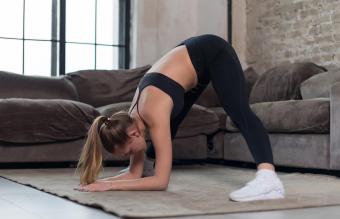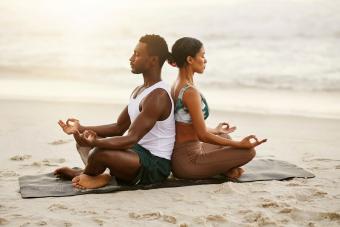
Ashtanga yoga is considered to be the most strenuous of the Hatha Yoga methods. Individuals who are very athletic in other areas enjoy it because of its equal focus on stamina, strength and flexibility.
Understanding the Practice
The translation of Ashtanga in Sanskrit is "ashta" - meaning eight-limbed; "and "yoga" - meaning union, yoke or power.
The eight levels to attaining spiritual enlightenment guide practitioners of Ashtanga yoga. As Ashtanga Yoga Canada explains, Indian sage Pantajali outlined the Eight Steps in the Yoga Sutras.
- Yamas: explores truth, morals and personal conduct
- Niyamas: contentment, surrender of the ego
- Asanas: steady poses
- Pranayama: control of breath and vital energy; together with asanas
- Pratyahara: withdrawal of the senses
- Dharana: mastering concentration
- Dhyana: examines meditation
- Samadhi: experiencing the super-conscious state
Similar to Bikram Yoga, Ashtanga relies on heat to purge the body of toxins and thus, clears both mind and body. The difference is that while exercisers perform Bikram in a room of 85-105 degrees, Ashtanga practitioners execute a vigorous series of poses, known as vinyasa, which generate intense heat inside the body. Yogis move through 240 postures in rapid succession, monitored by breath. The continuous flow produces a mighty sweat and greatly increases cardiovascular activity. However, Ashtanga purists frown on the practice being called a "workout."
In addition, many followers of this form observe what are called "yoga holidays:" full moon and new moon dates on which yoga is not performed, based on the body's response to moon cycles.
There are many teachers of this method in its exact form, but it's also sometimes referred to as "power yoga." Power yoga, while based on the Ashtanga style, is not always the exact method as taught by Sri K. Pattabhi.
Who Is Sri K. Pattabhi?
Sri K. Pattabhi developed the practice of Ashtanga yoga based on what he learned from Krishnamacharya in 1927. For more than 60 years, Pattabhi has taught at the Ashtanga Yoga Research Institute in Mysore, India.
He is one of the few yoga masters to not come to America and establish centers and cottage industries. Rather, those interested in learning and teaching the method go to India. Yoga teachers began practicing Ashtanga in America in the mid-1970s.
The Benefits of Ashtanga Yoga
In an excerpt from his book Ashtanga Yoga: Practice and Philosophy, author Gregor Maehle outlines the numerous benefits of the style. In addition to the powerful detoxification of the muscles and organs, practitioners of this yoga style experience an extended flexibility of ligaments, tendons and muscles. This method is also said to:
- Greatly improve circulation
- Relieve chronic pain by improving joint mobility and lubrication
- Increase the chances of weight loss
- Develop muscle tone
- Promote deeper sleep and a sense of calm well being
Proponents of the practice also believe that regular Ashtanga exercise reduces the symptoms of certain chronic illnesses, such as thyroid disorders, arthritis and circulatory problems.
A Note of Caution
Like many yogic postures, Ashtanga asanas are broken down into purposeful movements. Within reason, anyone at any age can perform the poses, but this style of yoga does require the practitioner to be in better physical condition. The Mayo Clinic outlines more practice guidelines for this and other yoga styles.
In addition, practicing Ashtanga yoga is generally not advisable if you're pregnant. While certain postures can be modified as the pregnancy advances, the practice raises the core body temperature to levels that may be harmful to the baby. Talk with your health practitioner regarding other forms of yoga that are safer to perform until the baby arrives.
Classes, DVDs and Books
Before starting any form of exercise, talk with your physician and research the practice. In addition, it's always best to first perform any yoga path under the guidance of an experienced teacher, who will not only teach you about the history and theory of the style, but also instruct and correct your postures and other physical attributes important to the practice and to avoid injury.
In addition to checking with a local fitness club or spa, the following resources can help you find certified Ashtanga yoga teachers and classes in your area:
No one source can ever provide a complete, unaltered view of a specific yoga method. But the following books and electronic media may assist with further study of Ashtanga yoga:
- The Ashtanga Yoga Collection - Led by Richard Freeman, a Pattabhi pupil, this DVD set is over four hours of practice and has introductory, general practice and intermediate levels.
- Short Forms DVD - For those who want to fit yoga into busy schedules, instructor David Swenson has created segments of activity as short as 15 minutes. The producers state this DVD is for beginners, but also advise learning the practice in a class before trying it at home.
- Ashtanga Yoga: The Practice Manual - Also by yogi David Swenson, this is a comprehensive, well-photographed book, designed for all experience levels.
- Ashtanga Yoga Book - Filled with illustrations and easy instructions, this is a good book for beginners.
The practice of yoga is a journey of many steps. Take the time to not only teach your body the motions, but also your mind the methodology.







